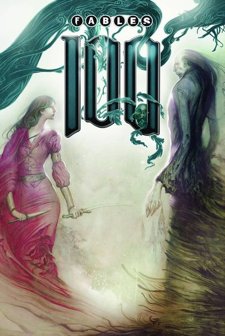Welcome to Wednesday Comics Pull-List, here on Tor.com! Every week we post reviews of a select handful of this week’s comic releases. From those reviews, we let you know what we would pull for keeps.
This week’s batch includes:
- 27 #1
- The Dark Tower: The Gunslinger–The Little Sisters of Eluria #1
- Fables #100
- Lady Mechanika #1
- Widowmaker #1 (of 4)
Aside from the big anniversary issue for Vertigo’s long-running Fables title, there wasn’t much of note happening this week. Although we had a lot to say about what did happen.
Also, starting next week, the weekly comics column here on Tor.com will be undergoing some changes, mixing in-depth coverage with some more news-centric items and, all in all, hopefully making it easier to talk about comics. Stay tuned!
 27 #1
27 #1
Written by Charles Soule
Art by Renzo Podesta
(Image Comics)
Pull: If you can! If you find it, pick it up; you’ll either like it and be happy, or hate it and make a handsome profit selling it online…
Matt says: By the time you read this, you may not be able to find 27 #1; at 8:30 this morning I bought the last copy at my comic book store, and copies are already showing up on Ebay for $30 or more. Hype, in this case, seems to have worked its magic; for a comic that’s at least partially about the mythology of rock and roll, this is probably very fitting.
Of course, the hype—and even the title—might seem to suggest that this book is going to be about the famous rockstars in the “27 club”; the aforementioned Ebay listings tack on names like Jimi Hendrix, Kurt Cobain, etc., as if any of these stars had something to do with the book. Those looking for even oblique references to their favorite dead rock gods will be largely disappointed, at least for now; issue #1 is all about Will Garland (whose first name is not actually given in this issue)—lead guitarist and songwriter behind The Fuzz, a fictitious band invented for this comic. Furthermore, while steeped in rock and roll mythology, this issue is not strictly about rock myths, per se; Will’s journey through issue #1 to recover the use of his left hand (nerve damage has kept him out of the rock scene for the last year) “by any means necessary” is a Faustian setup in no way limited to rock stories. And the romantic turn taken by the end of the issue—the dark, demonic powers that seem to fuel Will’s newfound genius creativity—is a parable common to all creative pursuits for at least the last two hundred years. In other words, writer Charles Soule is working with a full deck of creative mythologies, and 27 seems to pull freely from each of them in turn. Throw in some very simply numerology and the faintest whiff of the occult, and 27 has a full deck of storytelling references and inspirations at its disposal.
With so many big ideas fighting for screen time, it would be almost impossible for the first issue to really be anything but 22 pages of yet-untapped potential (23 if you count the rock poster on the first page—and on that note, why hasn’t the creative team bothered to set up www.thefizzband.com, the website so clearly splashed across page 1? It just seems like an obvious tie-in opportunity…). This issue is a quick, fun read—but right now it’s impossible to tell whether or not that potential is going to be realized. Meanwhile, it’s been said before but I’ll say it again: Renzo Podesta’s art is deceptively simple, more mood and ambiance than illustration, more gesture and insinuation than storytelling. I’m not sure if the book really needs the “golden age” size format (7.5“x10.5”), but the art slowly grows on you. The washes of texture and murky color in particular are well-suited to the story, and what the linework lacks in draftsmanship it makes up for in open space that allows the color to breathe.
It will be interesting to see where the series goes from here; the miniseries is only scheduled to run 4 issues, so I’m imagining that things are going to start happening fairly quickly from here. Furthermore, if issue #1 has the tendency to get bogged down in a lot of exposition, it’s also successfully told an opening vignette, ripe with resources for the rest of the series to draw upon. We’ll have to wait and see whether or not 27 lives up to its promises; in the meantime, issue #1 is worth giving a try.
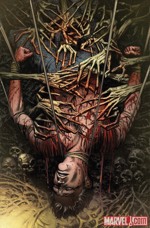 The Dark Tower: The Gunslinger–The Little Sisters of Eluria #1
The Dark Tower: The Gunslinger–The Little Sisters of Eluria #1
Written by Peter David
Art by Luke Ross & Richard Isanove
(Marvel Comics)
Pull: Meh… could go either way.
Annie says: I was a bit wary of this comic—initially the language sort of threw me for a loop because I wasn’t exactly sure who the heck was narrating but as the story progresses the story starts to pull itself together. Following the steps of his forefathers, Roland Deschain is youngest man to become a gunslinger. Of course, this hasn’t done anything but bring him more trouble. He was the only survivor from the Battle of Jericho Hill and now he’s on his way to reach the “mysterious Dark Tower.” When we first see Roland he’s on top of his horse, Topsy, definitely looking worse for wear. He makes it a point to tell Topsy that soon, he’ll get her to a doctor, which is followed by a narrator note, “Roland was once an honest man. It’s amazing how good he’s got at lying.”
As Topsy and Roland turn the corner, a town comes into sight. Thinking he and Topsy might find refuge there, he rides up to the town only to find it abandoned. He pokes around, innocently calls what is most certainly blood “splattered maroon stuff” and finds that the only living thing left in the town is a dog with a bum leg who has a taste for human flesh. Up until this point, it’s a pretty awesome, albeit vague, story about this guy wandering around a ghost town with a sick horse. Then he finds the body of a young boy (whose necklace says “James”) in a trough and then, all of a sudden, there are a million Shrek lookalikes lumbering towards Roland, all armed with what I think might be the legs of a lot of wooden chairs. Roland is bludgeoned and then attached to what looks like a zombie version of his horse Topsy and is about to be dragged…somewhere, when three zombie/vampire/nuns/old-school nurses show up to tell the ogres (Maybe? They refer to themselves as “Green Folk” but I don’t particularly care for that name.) that they need to release Roland because they “have no rights.” Rights to what, I’m not sure. Fast forward to Roland waking up from a series of dreams until finally he wakes up in what I’m assuming is an infirmary of sorts and we see someone’s hand touching his face, telling him to go back to sleep.
I don’t know…I don’t read a lot of Steven King and to be honest, I wanted to read this because it looked like it had something to do with zombies and the blurb on comixology.com made it sound a bit more interesting then it ended up being. The good news is, the comic itself isn’t awful. I don’t feel like I wasted my time. The artwork is pretty good. More of the story is told through the artwork, which isn’t necessarily a bad thing but, I just wasn’t sure what I should be paying attention to and what could be dismissed.
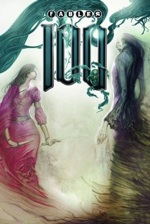 Fables #100
Fables #100
Written by Bill Willingham
Art by Mark Buckingham
(DC Comics / Vertigo)
Pull: Of course, but established fans only. It’s also good if you’re returning to the title after an absence, but if you’re looking for a gateway into the series, this is not it.
Chris says: Can we talk about the size of this thing, first? This single ten dollar issue of Fables is so massive it has a spine. The book is all original content, too, which is quite an undertaking.
A large part of the appeal of Fables for me is the growth of these fantasy characters into their real world settings. It’s more than just a meshing of fantasy and reality, it’s a continuation of the progression that these fables and characters have been taking since their creation centuries (or millennia) ago. These stories reflected the times they were written in and Fables shows that, even after the stories of these characters have been preserved on paper, this reflection never stops.
True to that, the assorted Fables in this book function very well in modern society. What they have a real problem with is dealing with the battles from worlds and times long defunct. The running thread of much of the series has been the Fables battle to overthrow the Adversary and reclaim the fantasy homeworlds they were forced to escape from. Once that was accomplished, however, much of the cast chose to remain in our modern, magic-less world. Although not where they were “born,” Earth has afforded many of these characters opportunities for personal growth and acceptance that would never have been able to occur in a static worlds born from stories. Bigby Wolf and Snow White would have never found each other as the people they were. Boy Blue and Prince Charming would have never discovered their inner courage. And, in regards to issue #100, Frau Totenkinder would have never found redemption.
Fables #100 concerns itself with a duel between Totenkinder (the witch from Hansel & Gretel) and Mr. Dark (or Duladan, as he is known), a powerful evil unleashed as an unwitting consequence of the Fables’s victory over the Adversary and the dissolution of his empire.
Mr. Dark wasted no time coming to the modern world, putting the Fables on the run and threatening to destroy the lives they had built here. Towards that end, Totenkinder, the only one powerful enough to confront him, marshaled her strength in a last ditch effort to seal away, or kill, Mr. Dark. This battle is where today’s issue opens.
And what a battle it is! Longtime Fables artist Mark Buckingham turns in some incredible work here, better even than the already robust work he does on this title month in and month out. His art is clear and powerful without being messy or lumpen, and while retaining a realistic edge in the midst of a fairytale tableau. The fight is clever and engaging, so much so that you start to resent being pulled away from it by vignettes from other characters.
While that is happening, Beauty goes into labor up at the Fable Farm, a battle just as tense, although presented far less dramatically than the Totenkinder/Dark duel.
[SPOILERS FOLLOW]
The winner of the duel again brings to mind the theme of the series, and how it mixes old fantasy with modern day in more than one regard. The Mr. Dark storyline (much like the Adversary storyline) has been structured like a high fantasy novel, and like a high fantasy novel, you expect a certain sort of ending. These are fantasy characters fighting a fantasy menace, and Willingham delivers exactly the kind of ending you would expect.
So, it’s all the more surprising when that ending ends up unraveling before the book is even finished. The Fables are barely able to reclaim their old NYC stomping grounds when they are forced into retreat, out of NYC, off the farm, and pretty much out of the modern world altogether. They put a brave face on this, and Mr. Dark has been given a severe setback, but the reality is certain. The Fables have lost.
It’s this ending which really shows that even 100 issues later, Fables is still fresh and still growing, and that the writer and his audience have established a strong level of trust that will allow it to keep growing past comfortable and familiar tropes. If this were the ending during the Adversary storyline, fans would have mutined and it’s doubtful the series would have survived to this point. That this ending now feels natural is a testament to the strength of this series.
To be fair, not all of issue #100 was as well done. There is a subplot involving Nurse Spratt that comes out of nowhere and feels completely awkward, despite the later events that justify it. On a personal note, there’s also an old-boy tone and smug cleverness that has pervaded the series ever since the war storylines began in earnest, and I’m eager to see it toned down in favor of the more character-centric dialogue from earlier Fables volumes.
The after-story extras are well done and substantial, however, and Bill Willingham’s art is…well, it’s really damn good. The man is a double-threat. (Can he sing? Can he dance? Can he act? Triple threat?) Ditto for Mark Buckingham’s prose storytelling abilities. Fans of the series are treated to another installment of “Burning Questions,” a series of short vignettes that charmingly fleshes out the every day lives of the Fables.
It has its stumbles, but all in all, Fables #100 is a momentous and satisfying issue that proves there’s yet more around the corner.
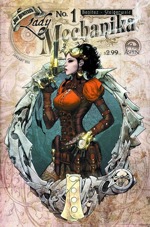 Lady Mechanika #1
Lady Mechanika #1
Writing and Art by Joe Benitez
(Aspen)
Pull: For either died-in-the-wool steampunk-devotees or those who like hot girls with guns no matter what the setting, this book is a sure bet. For everyone else, pass this one by.
Matt says: By this point, I’m assuming you either love steampunk or hate it. Over the last twenty years or so, the genre has risen from disarray and obscurity to dominate large swaths of the cultural landscape: witness the “Steampunk Fortnight” celebrated right here on Tor.com, for example. But like so many successful genres/subcultures, steampunk now risks finding itself the victim of its own success, as the inevitable backlash hits; all-too-familiar cries of “I’m sick to death of steampunk!” are already cropping up at every turn. Like black trenchcoats and leather ten years ago, Victorian style now seems to be the new “auto-tune” of the sci fi scene: a ubiquitous gimmick, more often than not used unthinkingly to put a slick face on mediocre storytelling.
I say this because, had Lady Mechanika come out ten years ago—say, alongside Kelly and Bachalo’s Steampunk or (sigh) Sonnenfeld’s Wild Wild West—it would have simply been fresh, interesting, and fun. Had it come out twenty years ago—alongside The Difference Engine—it would have been groundbreaking and visionary. But to come out in 2010, the book brings immediate suspicions of bandwagon-jumping. Alas, a new addition to the steampunk genre must today answer the hard question that novelty allowed us to overlook a decade or more ago: Why?
We are, then, left judging Lady Mechanika on two very different sets of criteria. As an action comic book, Mechanika is fun, with all of the slickness one has come to expect from Joe Benitez in particular and Aspen Studios in general. The girls are gorgeous, the tech is interesting, and if the storytelling occasionally suffers for the sake of “looking cool,” well, it’s not like the writing is all that complicated as to need sharp storytelling, right? The narrative in issue #1 is bogged down a bit by the usual clunky, unnecessary exposition—but it’s intertwined with some gorgeous establishing shots and great character-introducing splash pages. If you’ve grown up in the age of Image Comics, you’ll recognize this sort of book right away. Twenty years ago, it would have had ten variant covers and sold a million issues. Today, it’s got five variant covers and should at least turn a profit. By the measuring stick of creator-owned, adventure comic books, then, Lady Mechanika is a slick bit of fluff and a thoroughly enjoyable read.
As a bit of steampunk science fiction, however, I don’t yet see the point. Perhaps I’ve got it wrong; perhaps steampunk has been so thoroughly established as an independent genre that it no longer requires justification. Maybe it’s a format to tell any kind of story, the way “fantasy” or “paranormal teen romance” are. But in light of the very serious questions that have been asked around here lately about steampunk, I still have to wonder: why does this story need to be given a high-tech Victorian setting? There are a great many things still to be said about Victorian culture; about our own culture’s roots in (and continuing reflection of) Victorian culture; about the wistful yearning for a past unapologetically dominated by white men; and about the modernist faith in technology as a force of salvation. For all of these reasons, steampunk seems to me to be as vital a genre as you could ask for. But, lacking any engagement with themes that would necessitate such a setting, steampunk is simply fetishistic style over substance, blatant trend carpet-bagging for the sake of sales figures. And no matter how well established, every genre is cheapened by such practices. By the measuring stick of steampunk, then, Lady Mechanika is a cheap and tawdry affair, a marketing gimmick intended to convince you that this book is somehow different from every other gun-toting-hot-chick action comic out there.
Which brings me right back to where we started. At this point, you either love steampunk or you hate it; isn’t this the way of all fashion trends? What gets lost in this “debate” is the engagement with themes and ideas, the basis upon which we might judge a story on its own merits. For those of you who love the genre as a style, then, Lady Mechanika will not disappoint. It’s as gorgeous a steampunk adventure as you could ask for. For those of you who hate the genre as a style, this book is of course going to further churn your stomach. But for those few of you who may be looking to be convinced one way or the other, you’d best move along. Lady Mechanika is only preaching to the choir, here, and isn’t going to sell you on steampunk any more than Twilight is going to sell you on vampires.
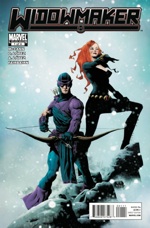 Widowmaker #1 (of 4)
Widowmaker #1 (of 4)
Written by Jim McCann
Art by David Lopez
(Marvel Comics)
Pull: Pass.
Annie says: “Someone is killing spies around the world, and now they’ve killed a friend of mine.” The story really could have started and stopped after this sentence was uttered, because, to be honest, I have no idea what this comic was about other than using that sentence for clarity. This was partially due to the fact that it’s the least complicated sentence uttered in the entire comic but mostly because it did more to explain the story than all 32 pages of panels.
My gripes with this comic are fairly common; too many locations were thrown in my face in such rapid fire succession that when the SHIELD heroes finally did show up I wasn’t exactly sure where they were. Under that same pretense, there were way too many different people being introduced way too quickly. Ambassadors? Analysts? Who are all of these people?!? The basic premise for this comic is that the SHIELD dudes find out that someone is hunting them…I think. Or one of them is being hunted. Someone is being hunted. That’s what I know.
This comic didn’t really sell itself to me all that well. I thought the cover art would translate into the actual comic but it didn’t. To be perfectly honest, the artwork reminded me a lot of Captain Planet; very Saturday morning cartoons-ish. Part of me thinks the reason I wasn’t so into this comic was because I’m not really a Marvel reader but I don’t buy into that excuse too much. This comic really tried to be new reader friendly (via the bios in the beginning and the white text explanations in under new characters) but, I’m a new reader and I still didn’t get it. While I’m sure there are more savvy people in this world than me, I just have a hard time believing anyone else bought into this comic and walked away knowing exactly what happened.
Annie Gala will most certainly miss the camaraderie of the Wednesday Comics Pull List.
When Matt Lampert isn’t writing about comics, he’s a philosophy professor in New York City.
Chris Greenland is already halfway to Fabletown. Wherever it is.










